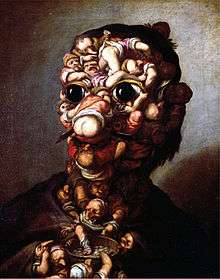Faustino Bocchi

Faustino Bocchi (1659–1742) was an Italian painter, active in Brescia, who specialized in bizarre paintings of dwarfs.
._Nano_assalito_da_un_gambero_e_soccorso_dai_compagni%2C_Padova%2C_Musei_Civici%2C_Museo_d'Arte.jpg)
Biography
He was son of Giacomo and Giulia Faioni, and was born in Brescia on June 17, 1659. We do not know if Bocchi ever moved from Brescia; Carboni, albeit with great uncertainty, cited a stay at the court of Florence, a stay that seems unlikely given the absolute silence of the Atoldi who also cited the three works painted by Bocchi for that court. What is certain is that Bocchi had a quiet life, and his study was presented as a sought-after place for cheerful conversationalists, enlivened by the music of the zither of which he was a good player.
Bocchi was a pupil of Everardi, a figurist, a painter of battles and bambocciate, who instructed him in this three genres; while the document Vinaccesi states that Bocchi was initially formed under Carlo Baciocchi and only later, when he became a friar, passed under Everardi: it was however a period short, completed in the year 1678 with the death of the master.
Bocchi died in Brescia on April 27th 1741.[1]
These were generally seen as humorous or satirical, and often scabrous pieces, though some resemble the decorative conceits of Arcimboldo, while others suggest the nightmarish world of Hieronymus Bosch. Cristiani cites this as the "capricious particularity to represent with his master paint-brush: the battles, the fights, the games, the dances, the feasts, and triumphs of the pygmies".[2] By some he is described as a genre painter of the Bamboccianti, specifically a Bambocciate di nani or arte pigmeo.
It is said that Bocchi's paintings were highly prized by Bergamesque collectors such as Giacomo Carrara and Ludovico Ferronati. Bocchi is said to have been the pupil of Angelo Everardi (il Fiamminghino or Fiammenghino). Enrico Albricci is said to have been his pupil for a spell.
._L'arrivo_della_sposa._Collezione_privata.jpg)
References
- ↑ Boselli, Camillo. "- Dizionario Biografico degli Italiani - Volume 11 (1969)". Treccani. Retrieved 17 March 2018.
- ↑ la capricciosa particolarità di rappresentare con maestro pennello, le battaglie, le lotte, i giochi , i balli , i conviti , e i trionfi de' pigmei.
- Painting at parish church of Zogno..
- John T Spike (1986). Centro Di, Kimball Museum of Art, Fort Worth, Texas, USA., eds. Giuseppe Maria Crespi and the Emergence of Genre Painting in Italy. pp. 68–69.
- Farquhar, Maria (1855). Ralph Nicholson Wornum, ed. Biographical catalogue of the principal Italian painters. Woodfall & Kinder, Angel Court, Skinner Street, London; Digitized by Googlebooks from Oxford University copy on Jun 27, 2006. p. 27.
- Federico Nicoli Cristiani (1807). Della Vita delle pitture di Lattanzio Gambara; Memorie Storiche aggiuntevi brevi notizie intorno a' più celebri ed eccelenti pittori Bresciani. Spinelli e Valgiti, Brescia. pp. 136–137.
- The Metropolitan Museum: The Eighteenth Century in Italy, Volume 1, By Jacob Bean and Felice Stampfle, page 23.